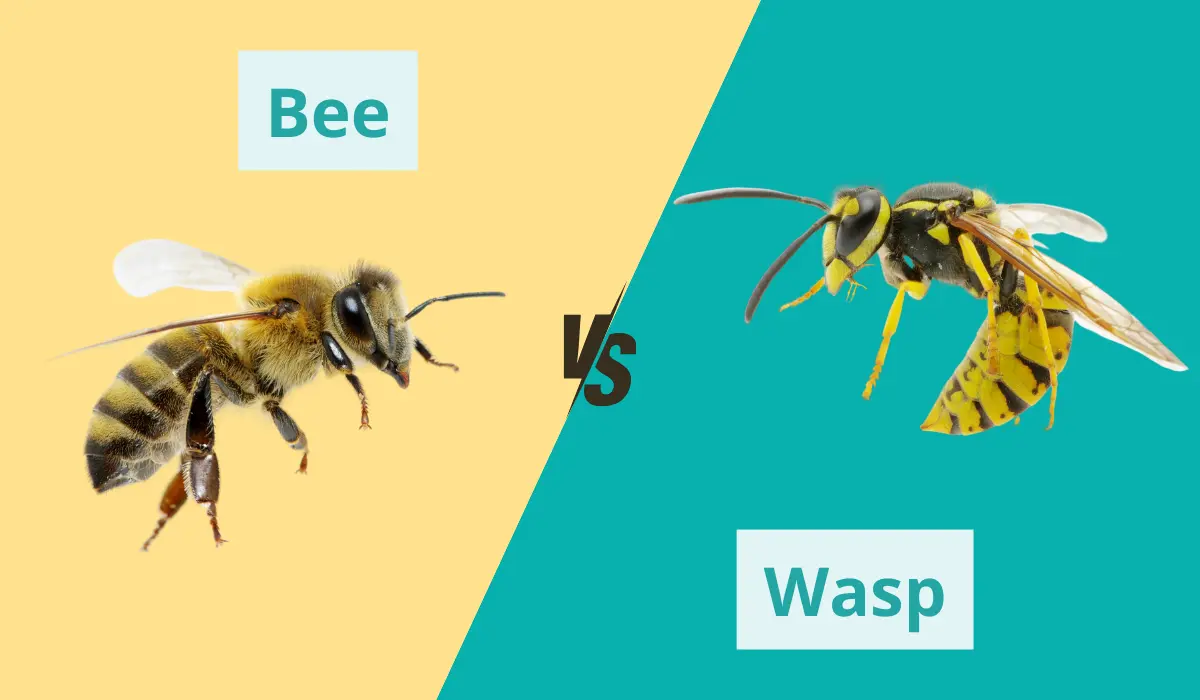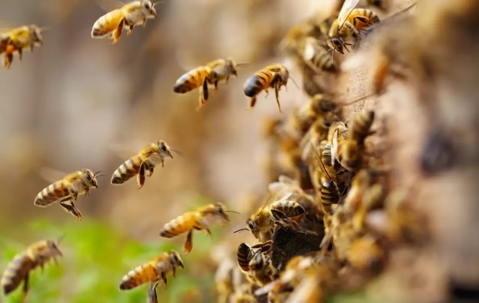Bees vs. Wasps: What’s the Difference?
Bees buzz around, busy with pollination and making honey, while wasps are the tough guys, hunting and scavenging.
Despite both packing a sting, they're different: bees are fluffy pollinators, dying after one sting, but wasps can hit you multiple times with their sleek bodies.
Why care? These critters play huge roles in nature and our lives. Dive in to discover the fascinating world of bees and wasps.

Key Takeaways
- Bees, including honeybees, bumble bees, and Africanized bees, are crucial for pollination and biodiversity and play a unique role in Florida's ecosystem.
- Wasps, such as yellow jackets, paper wasps, and hornets, provide natural pest control and pollination but can pose risks to humans and pets.
- Understanding the differences between bees and wasps is crucial in identifying and reacting appropriately to their presence.
- Recognizing signs of bee and wasp infestations is essential for preventing damage and potential harm.
- Proactive prevention and safe removal practices, including DIY tips and professional pest control services, are vital for effectively managing bees and wasps.
What to Know About Bees
Bees are important pollinators in ecosystems and vital for producing various crops.
Types of Bees Common in Florida
Florida hosts a range of bee species, each with unique traits that contribute to its local environment.
Species of Bees | Description |
Honeybees (Apis mellifera) | Golden-yellow with brown bands; known for producing honey and beeswax; social bees that live in large, well-organized bee hives managed by beekeepers. |
Bumblebees | Larger, fuzzy, black, and yellow bodies; live in smaller nests than honeybees; due to their size and strength; can pollinate flowers that honeybees cannot. |
(Apis mellifera scutellata) | Similar in appearance to honeybees but more aggressive; solitary bees that defend their nests vigorously; often called "killer bees" due to their defensive behavior. |
What Do Bees Do?
Pollination: Worker bees transfer pollen between flowering plants, helping them breed and produce fruits and seeds. This action supports many plants in the ecosystem.
Food Production: Many crops rely on bees as pollinators, including fruits, nuts, and vegetables; bee activity is directly linked to the quality and quantity of harvests.
Biodiversity: Through pollination, bees support the growth of wildflowers and plants, which promotes diverse habitats for various animals and other organisms.
Understanding Wasps
In Florida, understanding the variety of wasp species and their impact on the ecosystem is crucial for residents and visitors alike.
Common Wasp Species in Florida
Wasps can be beneficial but also pose risks in specific scenarios. Here are some types of wasps you should know of:
Species of Wasps | Description |
Yellow Jackets | Yellow and black striped bodies with narrow waists; prefer ground-nesting with paper materials in secluded. |
Paper Wasps | Long-legged with brownish bodies and yellow markings; construct umbrella-shaped nests from chewed wood fibers mixed with saliva; feed caterpillars to their larvae. |
Asian Giant Hornets (Vespa mandarinia) | Significantly larger than other wasp species, with a striking yellow and black striped body; known for their powerful sting and aggressive behavior. |
European Hornet (Vespa crabro) | Large with brown and yellow-orange stripes; prefer hollow trees but can also be found in attics and wall voids. |
Bald-Faced Hornet (Dolichovespula maculata) | Black with white markings on the face; builds large, football-shaped nests in trees or on the sides of buildings. |
Mud Daubers | Long, slender bodies with a thread-like waist; solitary wasps that construct nests out of mud, often on the sides of buildings. |
What Do Wasps Do?
Here’s a closer look at their dual role as both benefactors and challengers within our environment
- Natural Pest Control: Wasps feed on insects as food sources, such as aphids, caterpillars, and their pupae, helping as a natural pest control.
- Pollination: While foraging for food, wasps can inadvertently pollinate plants, contributing to the ecosystem's health.
- Risks to Humans and Pets: Wasp stings can lead to discomfort or allergic reactions.
- Wasp Colonies: Social wasps build extensive colonies in large numbers, which can become problematic when located near human activity.
Key Differences Between Bees and Wasps
To guide you in identifying these insects with ease, here are the distinguishing physical characteristics that set these stinging insects apart:
Characteristics | Bees | Wasps |
Body Shape | Plumper and more rounded | Slender with a narrow waist |
Size | Varies from small to medium | Typically, medium to large |
Thorax | Typically hairy, aiding in pollen collection | Usually smooth and shiny |
Coloring | Generally, a fuzzy yellow and black pattern | Smooth, with brighter yellow and black markings |
Antennae | Shorter and elbowed | Longer and more straight |
Hair | Fuzzy bodies, especially on pollen baskets | Less hair and more shiny |
Stinger | Barbed stinger and typically can sting only once before dying | Smooth stinger, allowing them to sting multiple times without dying |
Signs of a Bee or Wasp Infestation
Spotting an infestation early can prevent extensive damage and potential harm.
So, it is crucial to recognize where and what to look for when identifying bee and wasp nests in residential areas.
Identifying Bee and Wasp Nests
To distinguish between bee and wasp nests near homes in Florida, you should pay attention to several critical factors, such as:
Location
- Bees typically build nests in protected areas such as hollow trees and walls and occasionally in attics. They favor places that are partially protected from the elements.
- On the other hand, wasps often build nests under eaves, behind shutters, or inside grills. They are known to take advantage of human structures' shelter.
Size
- Bee nests, especially those of honeybees, can grow quite large due to their perennial nature. A single colony can expand significantly over time.
- Wasp nests vary with species; paper wasps create smaller, open-concept nests, while hornets and yellow jackets can create sizable, enclosed nests bigger than a basketball.
Appearance
- Bee nests are made of waxy substances and have a distinct, orderly hexagonal pattern.
- Wasp nests have a papery look because they are made from a mixture of wasp saliva and chewed wood pulp, resembling paper mâché.
Preventing Bees and Wasps
Effectively managing bees and wasps requires a dual approach:
Proactive prevention to deter them from settling in undesirable areas
Safe removal practices when establishing nests
DIY Prevention Tips
To keep bees and wasps at bay, you can follow these practical tips:
Prevention Measure | Description |
Seal Entry Points | Close gaps in siding, eaves, and foundations. Use silicone caulk or expandable foam for small cracks. |
Keep Food Covered | Tightly seal garbage cans and cover any food during outdoor events. |
Remove Attractants | Avoid overgrown gardens and standing water, which can attract insects. Trim plants regularly. |
Use Decoys | Hang fake nests or decoy wasps, as these insects are territorial and are less likely to build a nest near another. |
Maintain a Clean Yard | Remove fallen fruit and keep sugary spills to a minimum to avoid drawing in foragers. |
Choose Plants Wisely | Incorporate plants that repel bees and wasps, like citronella, eucalyptus, and marigold, into landscaping. |
Limit the Use of Bright Colors | Avoid using bright floral patterns for outdoor furnishings since they mimic flower colors and can attract bees and wasps. |
Safe Removal of Nests
Safe removal is crucial for minimizing risks such as wasps and bee stings. Here are the steps for careful removal as homeowners in Florida:
Identify the Nest: Determine the type of insect and the nest size. Consult a local expert for bee identification and conservation.
Plan at the Right Time: Target removal during dusk or dawn when wasps are least active.
Wear Protective Gear: Wear long sleeves, pants, gloves, and a hat or bee veil to protect yourself.
Prepare an Escape Route: Before starting, know how to quickly and safely leave the area if the insects become agitated.
Use Pesticides Appropriately: If you choose to use a pesticide, ensure it is specifically designed for the type of nest you are dealing with.
Do Not Use Fire or Water: These methods can be dangerous and ineffective.
When Is It Time to Call the Pros?
You might wonder when your DIY efforts morph into a call for reinforcements—especially when dealing with the buzzing conundrum of bees and wasps.
Here's the lowdown on when it’s time to dial up professional pest control companies (like us, Native Pest Management).
- Buzz Overload: If they find themselves hosting a full-blown concert of buzzing in their attic or walls, it's not the latest indie music festival—it's time for a professional.
- Recurring Sightings: A single wasp or bee can be a fluke. But a constant parade? That's a sign of an established colony.
